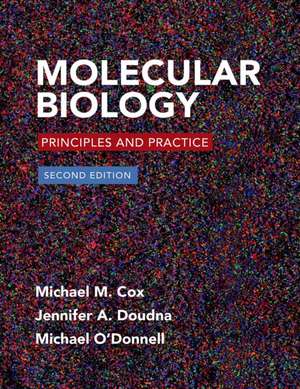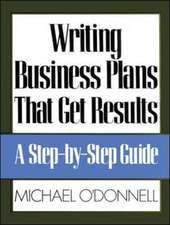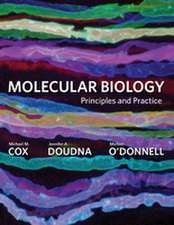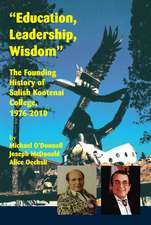Molecular Biology: W. H. Freeman
Autor Michael M. Cox, Michael O'Donnellen Limba Engleză Hardback – 7 mai 2015
Preț: 400.67 lei
Preț vechi: 421.75 lei
-5% Nou
Puncte Express: 601
Preț estimativ în valută:
76.67€ • 79.10$ • 63.98£
76.67€ • 79.10$ • 63.98£
Cartea nu se mai tipărește
Doresc să fiu notificat când acest titlu va fi disponibil:
Se trimite...
Preluare comenzi: 021 569.72.76
Specificații
ISBN-13: 9781464126147
ISBN-10: 1464126143
Pagini: 750
Ilustrații: 1300
Dimensiuni: 285 x 226 x 42 mm
Greutate: 1.92 kg
Ediția:Revizuită
Editura: MACMILLAN EDUCATION
Colecția W. H. Freeman
Seria W. H. Freeman
Locul publicării:New York, United States
ISBN-10: 1464126143
Pagini: 750
Ilustrații: 1300
Dimensiuni: 285 x 226 x 42 mm
Greutate: 1.92 kg
Ediția:Revizuită
Editura: MACMILLAN EDUCATION
Colecția W. H. Freeman
Seria W. H. Freeman
Locul publicării:New York, United States
Cuprins
I. Foundations
1. Evolution, Science, and Molecular Biology
2. DNA: The Repository of Biological Information
3. Chemical Basis of Information Molecules
4. Protein Structure
5. Protein Function
II. Nucleic Acid Structure and Methods
6. DNA and RNA Structure
7. Studying Genes
8. Genomes, Transcriptomes, and Proteomes
9. Topology: Functional Deformations of DNA
10. Nucleosomes, Chromatin, and Chromosome Structure
III. Information Transfer
11. DNA Replication
12. DNA Mutation and Repair
13. Recombinational DNA Repair and Homologous Recombination
14. Site-Specific Recombination and Transposition
15. Transcription: DNA-Dependent Synthesis of RNA
16. RNA Processing
17. The Genetic Code
18. Protein Synthesis
IV. Regulation
19. Regulating the Flow of Information
20. The Regulation of Gene Expression in Bacteria
21. The Transcriptional Regulation of Gene Expression in Eukaryotes
22. The Posttranscriptional Regulation of Gene Expression in Eukaryotes
Appendix: Model Organisms
Glossary
Solutions to Problems
Index
1. Evolution, Science, and Molecular Biology
2. DNA: The Repository of Biological Information
3. Chemical Basis of Information Molecules
4. Protein Structure
5. Protein Function
II. Nucleic Acid Structure and Methods
6. DNA and RNA Structure
7. Studying Genes
8. Genomes, Transcriptomes, and Proteomes
9. Topology: Functional Deformations of DNA
10. Nucleosomes, Chromatin, and Chromosome Structure
III. Information Transfer
11. DNA Replication
12. DNA Mutation and Repair
13. Recombinational DNA Repair and Homologous Recombination
14. Site-Specific Recombination and Transposition
15. Transcription: DNA-Dependent Synthesis of RNA
16. RNA Processing
17. The Genetic Code
18. Protein Synthesis
IV. Regulation
19. Regulating the Flow of Information
20. The Regulation of Gene Expression in Bacteria
21. The Transcriptional Regulation of Gene Expression in Eukaryotes
22. The Posttranscriptional Regulation of Gene Expression in Eukaryotes
Appendix: Model Organisms
Glossary
Solutions to Problems
Index
Notă biografică
Michael M. Cox is Assistant Chair, Department of Biochemistry at the University of Wisconsin-Madison. He received his B.A. in Biology from the University of Delaware and his Ph.D. in Biochemistry from Brandeis University. Cox's current research activity involves studies of the mechanism of action of proteins involved in genetic recombination. This work is focused on the bacterial RecA protein, the bacterial RecF, RecO, RecR, RecG, RuvA, and RuvB proteins, the yeast Rad 51 protein, and more broadly on the mechanism of the recombinational DNA repair of stalled replication forks.
Jennifer A. Doudna grew up on the Big Island of Hawaii, where she became interested in chemistry and biochemistry during her high school years. She is currently Professor of Molecular and Cell Biology and Professor of Chemistry at the University of California, Berkeley and an Investigator of the Howard Hughes Medical Institute. She received her B.A. in biochemistry from Pomona College and her Ph.D. from Harvard University, working in the laboratory of Jack Szostak, with whom she also did postdoctoral research.
Michael O'Donnell received his Ph.D. at the University of Michigan, where he worked under Charles Williams Jr. on electron transfer in the flavoprotein thioredoxin reductase. He performed postdoctoral work on E. coli replication with Arthur Kornberg and then on herpes simplex virus replication with I. Robert Lehman, both in the biochemistry department at Stanford University. O'Donnell then became a member of the faculty of Weill Cornell Medical College in 1986 and an investigator at the Howard Hughes Medical Institute in 1992 before moving to The Rockefeller University in 1996. O'Donnell is a member of the National Academy of Sciences.
Jennifer A. Doudna grew up on the Big Island of Hawaii, where she became interested in chemistry and biochemistry during her high school years. She is currently Professor of Molecular and Cell Biology and Professor of Chemistry at the University of California, Berkeley and an Investigator of the Howard Hughes Medical Institute. She received her B.A. in biochemistry from Pomona College and her Ph.D. from Harvard University, working in the laboratory of Jack Szostak, with whom she also did postdoctoral research.
Michael O'Donnell received his Ph.D. at the University of Michigan, where he worked under Charles Williams Jr. on electron transfer in the flavoprotein thioredoxin reductase. He performed postdoctoral work on E. coli replication with Arthur Kornberg and then on herpes simplex virus replication with I. Robert Lehman, both in the biochemistry department at Stanford University. O'Donnell then became a member of the faculty of Weill Cornell Medical College in 1986 and an investigator at the Howard Hughes Medical Institute in 1992 before moving to The Rockefeller University in 1996. O'Donnell is a member of the National Academy of Sciences.
Caracteristici
Moment of Discovery
Each chapter opens with a description of a significant breakthrough in molecular biology relevant to that chapter, as told by the scientist who made the discovery
Key Conventions
These brief paragraphs clearly lay out for students some fundamental principles often glossed over by instructors and textbooks.
How We Know
This end-of-chapter section combines fascinating stories of research and researchers with actual experimental data for students to analyze, often drawing on the work of the scientist featured in the chapter's "Moment of Discovery."
Problems (including Data Analysis Problem)
Problem sets at the end of each chapter give students the opportunity to think about and work with the chapter's key ideas. Each problem set\ concludes with a Data Analysis Problem, giving students the crucial experience of interpreting real data from actual research (most often the work described in the "How We Know" section). Solutions to the problems can be found on the companion Web site.
Unanswered Questions
A short section at the end of each chapter describes important areas still open to discovery, showing students that even well-covered subjects such as nucleic acid structure and DNA replication are far from fully explored.
Highlights
Throughout each chapter, special features focus on fascinating topics that enhance student understanding of the concepts:
- Medicine looks at diseases that arise from defects in biochemical pathways, or examples of how concepts learned in molecular biology have contributed drug therapies or other treatments.
- Technology focuses on cutting-edge molecular biology methods that students will likely be hearing about or even using in the future.
- Evolution reveals the role of molecular biology research in understanding key biological processes and the connections between organisms.
- A Closer Look highlights a wide variety of additional, intriguing topics.
Each chapter opens with a description of a significant breakthrough in molecular biology relevant to that chapter, as told by the scientist who made the discovery
Key Conventions
These brief paragraphs clearly lay out for students some fundamental principles often glossed over by instructors and textbooks.
How We Know
This end-of-chapter section combines fascinating stories of research and researchers with actual experimental data for students to analyze, often drawing on the work of the scientist featured in the chapter's "Moment of Discovery."
Problems (including Data Analysis Problem)
Problem sets at the end of each chapter give students the opportunity to think about and work with the chapter's key ideas. Each problem set\ concludes with a Data Analysis Problem, giving students the crucial experience of interpreting real data from actual research (most often the work described in the "How We Know" section). Solutions to the problems can be found on the companion Web site.
Unanswered Questions
A short section at the end of each chapter describes important areas still open to discovery, showing students that even well-covered subjects such as nucleic acid structure and DNA replication are far from fully explored.
Highlights
Throughout each chapter, special features focus on fascinating topics that enhance student understanding of the concepts:
- Medicine looks at diseases that arise from defects in biochemical pathways, or examples of how concepts learned in molecular biology have contributed drug therapies or other treatments.
- Technology focuses on cutting-edge molecular biology methods that students will likely be hearing about or even using in the future.
- Evolution reveals the role of molecular biology research in understanding key biological processes and the connections between organisms.
- A Closer Look highlights a wide variety of additional, intriguing topics.
Caracteristici noi
Chapter 1. Evolution, Science, and Molecular Biology
Updated discussions on evolution and the scientific method.
Chapter 2. DNA: The Repository of Biological Information
Updated discussion of the central dogma
Updated and expanded discussion of the types of RNA
Chapter 3. Chemical Basis of Information Molecules
New Moment of Discovery
Expanded discussion of nucleosides
Revised and expanded section: The Hydrophobic Effect Brings Together Nonpolar Molecules
New section: Electronic Interactions Between Bases in Nucleic Acids
Chapter 4. Protein Structure
Expanded section: Amino Acids Are Categorized by Chemical Properties
Significantly expanded discussion of protein purification, including Highlight 4-1
New section: Intrinsically Unstructured Proteins
Expanded section on protein families
Significantly expanded section on protein folding and computational biology
Chapter 5. Protein Function
New Moment of Discovery
Chapter 6. DNA and RNA Structure
Expanded discussion of the instability of RNA
New Highlight (6-1 Technology)
New discussion of riboswitches
Chapter 7. Studying Genes
Expanded discussion on obtaining DNA fragments to clone
Thoroughly updated section on next-gen and other modern DNA sequencing technologies.
New section on genome editing, incorporating the exciting new advances with programmable nucleases
Chapter 8. Genomes, Transcriptomes, and Proteomes
Expanded Highlight 8-1, now including discussion of the microbiome
Updated section on noncoding DNA
Expanded section on mass spectrometry
10. Nucleosomes, Chromatin, and Chromosome Structure
New Moment of Discovery
Significantly expanded discussion of histone modifications, including a new table
Chapter 11. DNA Replication
Expanded discussion of the b sliding clamp
Expanded discussion of the Pol III holoenzyme
Updated and expanded discussion of eukaryotic replication forks
Updated and expanded section: Eukaryotic Origins "Fire" Only Once per Cell Cycle
New section: Telomeres and Telomerase Solve the End Replication Problem in Eukaryotes
New Highlight (11-2): Short Telomeres Portend Aging Diseases
Chapter 12. DNA Mutation and Repair
New Moment of Discovery
New table (overview of DNA repair processes)
Chapter 13. Recombinational DNA Repair and Homologous Recombination
Updated and expanded sections on double-strand break repair and reconstruction of replication forks
Updated section on meiotic recombination
Chapter 14. Site-Specific Recombination and Transposition
Updated and expanded introductory section on transposable elements and site-specific recombination
Updated and expanded section: Precise DNA Rearrangements Are Promoted by Site-Specific Recombinases
Reorganized section on the use of site-specific recombination systems in biotechnology
Updated and expanded sections on transposition
Chapter 15. Transcription: DNA-Dependent Synthesis of RNA
Updated section on transcription elongation
Updated and expanded discussion on role of transcription factors
Updated and expanded discussion of termination mechanisms among RNA polymerases
Chapter 16. RNA Processing
Streamlined chapter organization
Expanded discussion of P bodies
Chapter 18. Protein Synthesis
Streamlined chapter organization
Updated discussion on protein release factors
Updated discussion on nuclear export signals
Chapter 19. Regulating the Flow of Information
Updated section: Gene Expression Is Regulated through Feedback Loops (now includes inducer exclusion)
Chapter 22. The Posttranscriptional Regulation of Gene Expression in Eukaryotes
Expanded section on alternative splicing, including ESEs and ESSs
Updated section on RNA interference
New section: RNAs Regulate a Myriad of Cellular Processes
Updated section on the developmental potential of stem cells
Updated discussions on evolution and the scientific method.
Chapter 2. DNA: The Repository of Biological Information
Updated discussion of the central dogma
Updated and expanded discussion of the types of RNA
Chapter 3. Chemical Basis of Information Molecules
New Moment of Discovery
Expanded discussion of nucleosides
Revised and expanded section: The Hydrophobic Effect Brings Together Nonpolar Molecules
New section: Electronic Interactions Between Bases in Nucleic Acids
Chapter 4. Protein Structure
Expanded section: Amino Acids Are Categorized by Chemical Properties
Significantly expanded discussion of protein purification, including Highlight 4-1
New section: Intrinsically Unstructured Proteins
Expanded section on protein families
Significantly expanded section on protein folding and computational biology
Chapter 5. Protein Function
New Moment of Discovery
Chapter 6. DNA and RNA Structure
Expanded discussion of the instability of RNA
New Highlight (6-1 Technology)
New discussion of riboswitches
Chapter 7. Studying Genes
Expanded discussion on obtaining DNA fragments to clone
Thoroughly updated section on next-gen and other modern DNA sequencing technologies.
New section on genome editing, incorporating the exciting new advances with programmable nucleases
Chapter 8. Genomes, Transcriptomes, and Proteomes
Expanded Highlight 8-1, now including discussion of the microbiome
Updated section on noncoding DNA
Expanded section on mass spectrometry
10. Nucleosomes, Chromatin, and Chromosome Structure
New Moment of Discovery
Significantly expanded discussion of histone modifications, including a new table
Chapter 11. DNA Replication
Expanded discussion of the b sliding clamp
Expanded discussion of the Pol III holoenzyme
Updated and expanded discussion of eukaryotic replication forks
Updated and expanded section: Eukaryotic Origins "Fire" Only Once per Cell Cycle
New section: Telomeres and Telomerase Solve the End Replication Problem in Eukaryotes
New Highlight (11-2): Short Telomeres Portend Aging Diseases
Chapter 12. DNA Mutation and Repair
New Moment of Discovery
New table (overview of DNA repair processes)
Chapter 13. Recombinational DNA Repair and Homologous Recombination
Updated and expanded sections on double-strand break repair and reconstruction of replication forks
Updated section on meiotic recombination
Chapter 14. Site-Specific Recombination and Transposition
Updated and expanded introductory section on transposable elements and site-specific recombination
Updated and expanded section: Precise DNA Rearrangements Are Promoted by Site-Specific Recombinases
Reorganized section on the use of site-specific recombination systems in biotechnology
Updated and expanded sections on transposition
Chapter 15. Transcription: DNA-Dependent Synthesis of RNA
Updated section on transcription elongation
Updated and expanded discussion on role of transcription factors
Updated and expanded discussion of termination mechanisms among RNA polymerases
Chapter 16. RNA Processing
Streamlined chapter organization
Expanded discussion of P bodies
Chapter 18. Protein Synthesis
Streamlined chapter organization
Updated discussion on protein release factors
Updated discussion on nuclear export signals
Chapter 19. Regulating the Flow of Information
Updated section: Gene Expression Is Regulated through Feedback Loops (now includes inducer exclusion)
Chapter 22. The Posttranscriptional Regulation of Gene Expression in Eukaryotes
Expanded section on alternative splicing, including ESEs and ESSs
Updated section on RNA interference
New section: RNAs Regulate a Myriad of Cellular Processes
Updated section on the developmental potential of stem cells
Descriere
Written and illustrated with unsurpassed clarity, Molecular Biology: Principles and Practice introduces fundamental concepts while exposing students to how science is done. The authors convey the sense of joy and excitement that comes from scientific discovery, highlighting the work of researchers who have shaped the field today.










